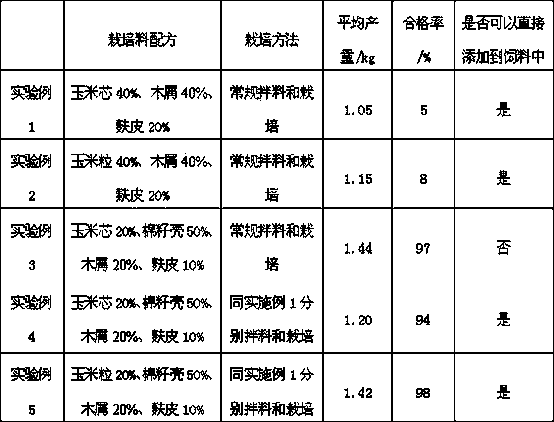Edible fungus cultivation method for increasing utilization rate of waste fungus stick
A cultivation method and edible fungus technology, applied in the field of papermaking, can solve the problems of affecting the growth of livestock, having peculiar smell, reducing the content of gossypol, etc., and achieving the effects of excellent water regulation function, saving water replenishment process, and strong water retention and slow release.
- Summary
- Abstract
- Description
- Claims
- Application Information
AI Technical Summary
Problems solved by technology
Method used
Image
Examples
Embodiment 1
[0030] A method for cultivating edible fungi that improves the utilization rate of waste fungus sticks, comprising the following steps:
[0031] S1. Prepare the cultivation material;
[0032] In terms of mass percentage, the cultivation material includes the following raw materials: 20% corn kernels, 50% cotton seed hulls, 20% sawdust, and 10% bran.
[0033] Then, the cottonseed hulls are mixed separately, and the other raw materials are mixed together. During the mixing process, lime is added to adjust the pH of the cottonseed hulls and the mixture to 14, and the water content reaches 65%. The cottonseed hulls and the mixture are respectively obtained.
[0034] S2. Bagging:
[0035] The cottonseed shell material is packed into bags, then covered with newspapers, and then the mixture is packed into bags; the packed cultivation bags are sealed and then sterilized.
[0036] S3. Vaccination:
[0037] Open the two ends of the cultivation bag respectively to inoculate, and then ...
Embodiment 2
[0041] A method for cultivating edible fungi that improves the utilization rate of waste fungus sticks, comprising the following steps:
[0042] S1. Prepare the cultivation material;
[0043] In terms of mass percentage, the cultivation material includes the following raw materials: 25% corn kernels, 50% cotton seed hulls, 15% sawdust, and 10% millet bran.
[0044] Then the cottonseed husks are mixed separately, and the other raw materials are mixed together. During the mixing process, a water-absorbing agent with a mass fraction of 1% of the dry material is added for mixing, and the water content reaches 65%. The cottonseed husk material and the mixture are respectively obtained. And during the mixing process, lime is added to adjust the pH of the cottonseed shell material and the mixture to 14.
[0045] S2. Bagging:
[0046] The cottonseed shell material is packed into bags, then covered with newspapers, and then the mixture is packed into bags; the packed cultivation bags...
Embodiment 3
[0052] A method for cultivating edible fungi that improves the utilization rate of waste fungus sticks, comprising the following steps:
[0053] S1. Prepare the cultivation material;
[0054] In terms of mass percentage, the cultivation material includes the following raw materials: 25% corn kernels, 50% cotton seed hulls, 15% sawdust, and 10% sweet potato seedling powder.
[0055] Then, the cottonseed husks are mixed separately, and the other raw materials are mixed together. During the mixing process, a water-absorbing agent with a mass fraction of 2% of the dry material is added for mixing, and the water content reaches 65%. The cottonseed husk material and the mixture are respectively obtained. And during the mixing process, lime is added to adjust the pH of the cottonseed shell material and the mixture to 13.
[0056] S2. Bagging:
[0057] The cottonseed shell material is packed into bags, then covered with newspapers, and then the mixture is packed into bags; the packe...
PUM
 Login to View More
Login to View More Abstract
Description
Claims
Application Information
 Login to View More
Login to View More - R&D
- Intellectual Property
- Life Sciences
- Materials
- Tech Scout
- Unparalleled Data Quality
- Higher Quality Content
- 60% Fewer Hallucinations
Browse by: Latest US Patents, China's latest patents, Technical Efficacy Thesaurus, Application Domain, Technology Topic, Popular Technical Reports.
© 2025 PatSnap. All rights reserved.Legal|Privacy policy|Modern Slavery Act Transparency Statement|Sitemap|About US| Contact US: help@patsnap.com

